Acalypha, plant care and growing guide
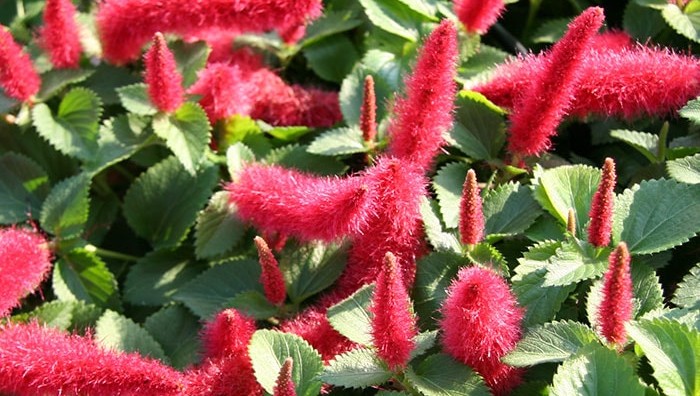
The genus Acalypha includes annual and perennial flowering plants of the Euphorbiaceae family. They originate from tropical and subtropical areas, namely from Indonesia and Polynesia. They grow as herbaceous, shrubby, or arborescent plants, with alternate leaves, petiolate, stipules, and serrated leaves. The inflorescences differ from one species to another and are positioned terminally or axially.
Species and varieties
Among the species of Acalypha, the most common are:
- Acalypha hispida, popularly named the chenille plant, and it is often used as an indoor plant due to its decorative inflorescences. It can reach a height of 1.5-3 m, but when used as a houseplant it reaches much lower heights. It is a dioecious species, including distinct male and female plants. Female plants have long, fluffy inflorescences, colored in red or purple.
- Acalypha wilkesiana is a subshrub and is distinguished through its copper-maroon leaves. Unisexual flowers are clustered in small spikes. It has two varieties: Musaica, which has a mosaic of colors on the leaves and Marginata, with brown leaves with copper reflections and pink edges.
- Acalypha godseffiana has green leaves with white edges. It can reach a height of 60-80 cm.
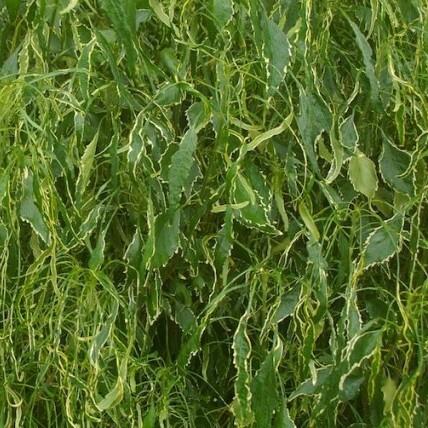
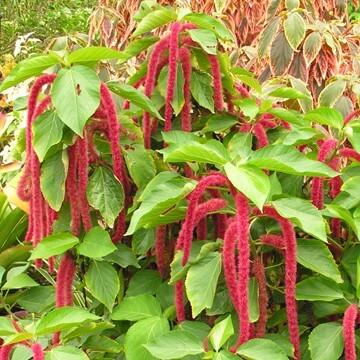
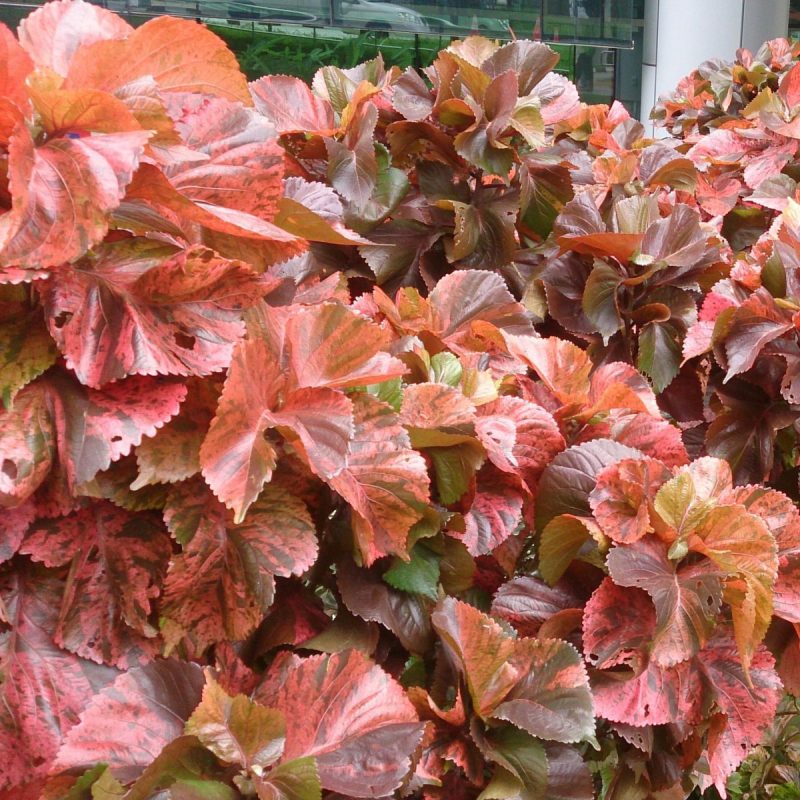
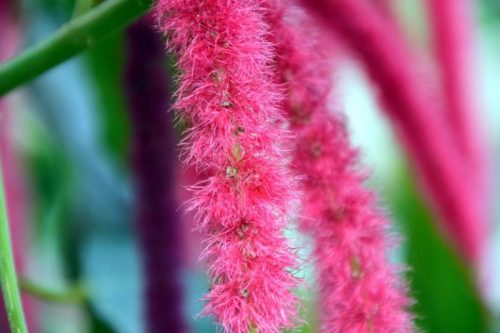
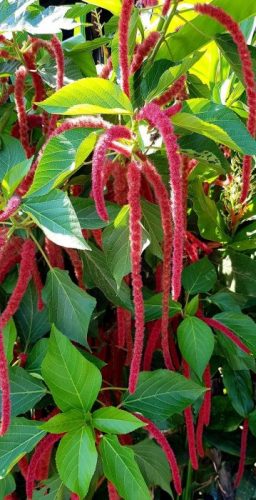
Environmental conditions
Light. It is a light-loving plant, so it is recommended to be placed near a window towards the south, behind a thin curtain, where it can benefit from sunlight for most of the day.
Temperature. The optimum temperature range for this plant is 20-24° C. In winter it should be kept in a cooler room, at temperatures of 10-12.
Air humidity. It is sensitive when it comes to atmospheric humidity and it does not tolerate dry air, so it is recommended to spray the leaves every day. To ensure constant humidity, you can place the pot in a bowl of moist gravel. If the air is too dry, the plant will gradually lose its leaves.
Substrates. It tolerates a slightly heavier substrate, which ensures good water drainage. It can be made of leaf soil, gravel, compost, and sand.
Recommended products
-
You can find products on a different store
Change Store -
You can find products on a different store
Change Store -
You can find products on a different store
Change Store -
You can find products on a different store
Change Store -
You can find products on a different store
Change Store -
You can find products on a different store
Change Store -
You can find products on a different store
Change Store -
You can find products on a different store
Change Store -
You can find products on a different store
Change Store -
You can find products on a different store
Change Store -
You can find products on a different store
Change Store -
You can find products on a different store
Change Store -
You can find products on a different store
Change Store -
You can find products on a different store
Change Store -
You can find products on a different store
Change Store -
You can find products on a different store
Change Store -
You can find products on a different store
Change Store -
You can find products on a different store
Change Store -
You can find products on a different store
Change Store -
You can find products on a different store
Change Store -
You can find products on a different store
Change Store -
You can find products on a different store
Change Store -
You can find products on a different store
Change Store -
You can find products on a different store
Change Store
Watering
Watering should be done moderately and constantly between June and September so that the substrate always remains moist. In winter, in order to favor dormancy, the amount of watering done and its frequency should be reduced.
Fertilization
Acalypha needs to be fertilized regularly during the growing season, from May to October. The most suitable fertilizer is liquid fertilizer, but you can also use a controlled-release fertilizer in the form of bars or spheres. In winter, no more fertilizer is applied in order to keep the plant in the dormancy period.
Recommended products
-
You can find products on a different store
Change Store -
You can find products on a different store
Change Store -
You can find products on a different store
Change Store -
You can find products on a different store
Change Store -
You can find products on a different store
Change Store -
You can find products on a different store
Change Store -
You can find products on a different store
Change Store -
You can find products on a different store
Change Store -
You can find products on a different store
Change Store -
You can find products on a different store
Change Store -
You can find products on a different store
Change Store -
You can find products on a different store
Change Store -
You can find products on a different store
Change Store -
You can find products on a different store
Change Store -
You can find products on a different store
Change Store -
You can find products on a different store
Change Store -
You can find products on a different store
Change Store -
You can find products on a different store
Change Store -
You can find products on a different store
Change Store -
You can find products on a different store
Change Store -
You can find products on a different store
Change Store -
You can find products on a different store
Change Store -
You can find products on a different store
Change Store -
You can find products on a different store
Change Store
Repotting
Acalypha should normally be transplanted annually, between February and May. It has fast growth, so in the beginning, it is recommended to move the plant to a larger pot. When the plant reaches the desired size, it is recommended to partially replace the substrate annually, without changing the pot.
Pruning
To maintain the shape of the plant and to also grow new leaves, it is recommended to cut the stems and branches in half, every year, in February-March. Dry, leafless stems should be completely removed.
Recommended products
-
You can find products on a different store
Change Store -
You can find products on a different store
Change Store -
You can find products on a different store
Change Store -
You can find products on a different store
Change Store -
You can find products on a different store
Change Store -
You can find products on a different store
Change Store -
You can find products on a different store
Change Store -
You can find products on a different store
Change Store -
You can find products on a different store
Change Store -
You can find products on a different store
Change Store -
You can find products on a different store
Change Store -
You can find products on a different store
Change Store -
You can find products on a different store
Change Store -
You can find products on a different store
Change Store -
You can find products on a different store
Change Store -
You can find products on a different store
Change Store -
You can find products on a different store
Change Store -
You can find products on a different store
Change Store -
You can find products on a different store
Change Store -
You can find products on a different store
Change Store -
You can find products on a different store
Change Store -
You can find products on a different store
Change Store -
You can find products on a different store
Change Store -
You can find products on a different store
Change Store
Propagation
Propagation is done in spring or autumn, through cuttings – cut 10-15 cm from the top of the plant and from one year-portions of shoots. For rooting, the cuttings need a constant temperature of 25° C and high atmospheric humidity. In order to favor their rooting, it is recommended to use rooting or growth hormones.
Recommended products
-
You can find products on a different store
Change Store -
You can find products on a different store
Change Store -
You can find products on a different store
Change Store -
You can find products on a different store
Change Store -
You can find products on a different store
Change Store -
You can find products on a different store
Change Store -
You can find products on a different store
Change Store -
You can find products on a different store
Change Store -
You can find products on a different store
Change Store -
You can find products on a different store
Change Store -
You can find products on a different store
Change Store -
You can find products on a different store
Change Store -
You can find products on a different store
Change Store -
You can find products on a different store
Change Store -
You can find products on a different store
Change Store -
You can find products on a different store
Change Store -
You can find products on a different store
Change Store -
You can find products on a different store
Change Store -
You can find products on a different store
Change Store -
You can find products on a different store
Change Store -
You can find products on a different store
Change Store -
You can find products on a different store
Change Store -
You can find products on a different store
Change Store -
You can find products on a different store
Change Store
Diseases and pests
In environmental conditions of high temperatures and dry air, mites can appear. The plant is also sensitive to whiteflies and mealybugs.
Recommended products
-
You can find products on a different store
Change Store -
You can find products on a different store
Change Store -
You can find products on a different store
Change Store -
You can find products on a different store
Change Store -
You can find products on a different store
Change Store -
You can find products on a different store
Change Store -
You can find products on a different store
Change Store -
You can find products on a different store
Change Store -
You can find products on a different store
Change Store -
You can find products on a different store
Change Store -
You can find products on a different store
Change Store -
You can find products on a different store
Change Store -
You can find products on a different store
Change Store -
You can find products on a different store
Change Store -
You can find products on a different store
Change Store -
You can find products on a different store
Change Store -
You can find products on a different store
Change Store -
You can find products on a different store
Change Store -
You can find products on a different store
Change Store -
You can find products on a different store
Change Store -
You can find products on a different store
Change Store -
You can find products on a different store
Change Store -
You can find products on a different store
Change Store -
You can find products on a different store
Change Store
In addition:
- the plant needs temperatures of 15° C during the night in order to bloom. The flowers blossom between April and October.
- after cutting, spray with water more often.
- in Acalypha Wilkesiana, non-important flowers are removed in order to keep the shrub compact.
- Caution! The plant must be handled with care, because all parts of the plant are toxic to humans and animals.















































































































































































































































































































































































































































